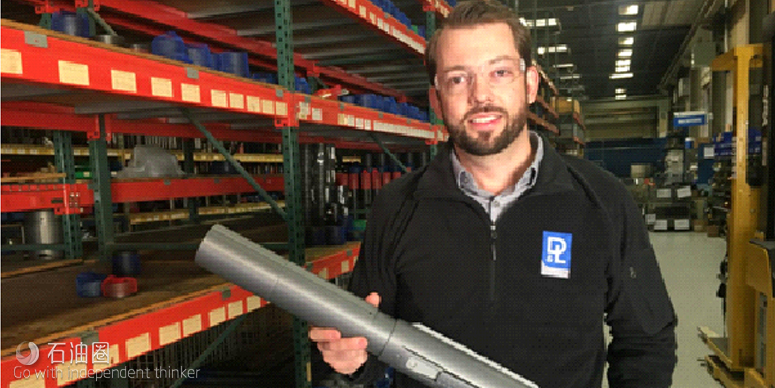The downhole environment of an oil and gas well is highly dynamic and cramped. Unable to physically see and measure in person what is happening downhole, the petroleum industry must rely on the next best thing: digital technologies.
The push for more and better data is dependent on the space made available for the sensors to measure, record and transmit without impeding the flow of oil and gas. As wells become increasingly more complex, more space downhole is needed to accommodate that digital footprint.
After learning of the need for more space around the tubing anchors from a client attending a tradeshow, the designers at D&L Oil Tools began development on what would become the company’s line of Trilobite Anchor tools.
Slim design
Officially released in late 2017, the patent-pending design of the anchors features three heat-treated steel alloy slips to maximize holding in tension and compression. The spacing of the anchor components creates additional space to allow increased annular flow and capillary tube bypassing without compromising a 5½-in.by-27⁄8-in. tubing size.
“With a slimline bypass style design, we were able to eliminate extra material while making the slips a little bit bigger than the rest of the tool body,” said Heath Bringham, senior sales engineer for D&L Oil Tools and original designer of the tool. “The body is no bigger than the tubing couplings that run up to the surface of the well.”
The area around the tool has been maximized to accommodate the need to run multiple capillary lines or monitoring cables past the tubing couplings while also providing space for gas/debris bypass around the slips.
“We have customers who make downhole gauges that require a quarter-inch or smaller fiber-optic or electrical cable be run alongside the tool for operation,” he said. “With our anchor tool, there is plenty of space to run one or multiple cables. We recommend anything up to 3⁄8 in. or smaller diameter line. You can place them right along the outside of the tool between the slips, and the line will be protected and not take up any extra room.”
He noted the added space also is beneficial to production in that gas in the well is able to rise naturally beyond the anchor, allowing downhole pumps to work efficiently.
“The unique thing about our tool is that not only does it have that maximum reduction on the outside diameter [OD] of the tool,” Bringham said, “we were able to keep the maximum inner diameter [ID] through it as well. In 5½-in. casing, a 27⁄8-in. tubing connection with a 2.44-in. ID is known as a big bore tool. Most operators aren’t really looking for much bigger than that.
“Not only do they have the area for gas to rise and to run whatever they want along the outside of the tool, they also can run larger pumps down through their tubing because the Trilobite tool has a fullbore ID. Most tools that have an OD reduction like the Trilobite tool require smaller ID tubing through the tool to accommodate that reduction,” he said.
Another feature of the anchor tool is that it also serves as “catcher,” Bringham said.
“If part of the tubing happens to part, the tool prevents the tubing from dropping to the bottom of the well,” he said.
The Trilobite product name was inspired by the combination of “tri” for the three slips, “lob” for it being a lobe tool and “bite” for it being a way for things to bypass as well as the tool’s literal bite, which keeps it in place, according to Heath Bringham (pictured), the original developer of the tool.
Hydraulic or mechanical?
There are two tool-activation options. One is the Trilobite Hydro Anchor that is hydraulically set. Pressuring up the plugged tubing activates internal hydraulics to actuate and set the slips into the casing. Releasing the slip is accomplished by pulling the tool straight up, according to Bringham. The anchor is available for 5½-in. and 7-in. casing sizes.
The other option is the Trilobite Quarter Turn Anchor that is mechanically set from the surface. “With it, the slips are set by manipulating the tubing at the surface,” he said. “A quarter turn to the right sets the slips and another quarter turn to the right releases them.”
The mechanical anchor is available for 5½-in. casing. The company is in the process of filling out the product line with additional sizes of tools.
“We started with those sizes initially to help familiarize people with the tool and to start using it,” he said. “We are working on tools in sizes of 4½ in.-by-23⁄8 in., 7 in.-by-27⁄8 in., and 7 in.-by-3½ in. in both product lines that we hope to roll out in 2018.”
The decision to use one versus the other depends on an operator’s preference and well design. “It is hard to make a one-size-fits-all kind of tool,” Bringham said. “We had a design that lent itself well to both styles so we made both to accommodate our customers.”
The Trilobite Hydro and Trilobite Quarter Turn Anchor designs were fi led with the U.S. Provisional Patent Office in June 2017 and will undergo a full patent process this year.


 石油圈
石油圈
